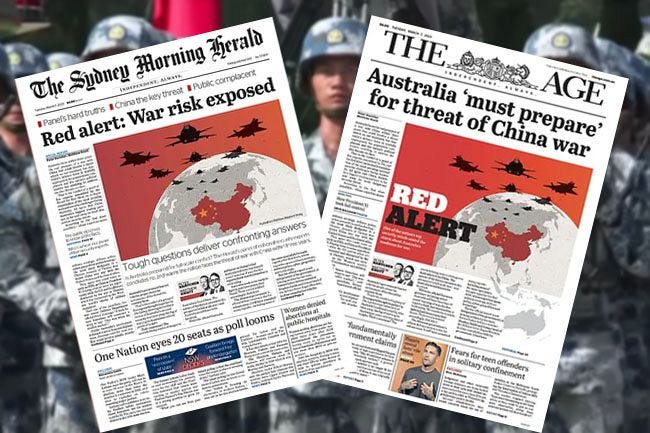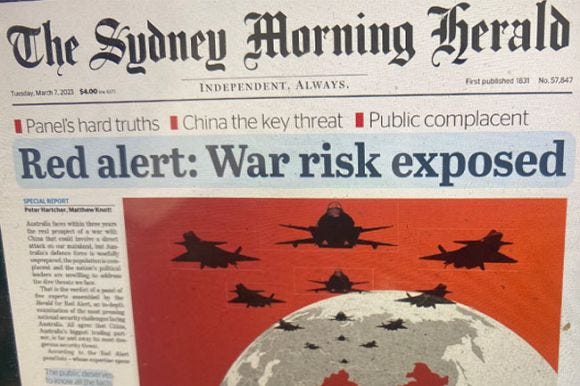'Red Alert' is a paper tiger
That’s the headline for my latest piece in Independent Australia, responding to some appalling warmongering from the Nine papers. The main point is that a seaborne invasion of Taiwan would be doomed to failure. Everyone knows this, but all the important players have good reason to deny it.
'Red Alert' is a paper tiger
By John Quiggin | 10 March 2023, 7:00am | 9 comments |

As Nine newspapers attempt to spread panic about a Chinese invasion, Professor John Quiggin explains why the logistics of such an event happening are unrealistic.
ON 6 JUNE 1944 (D-Day), the largest seaborne invasion in history took place in Normandy. Over 150,000 Allied soldiers crossed the English Channel and assaulted German positions on five sandy beaches, covering nearly 80 kilometres.
The surprise was complete. A successful deception operation had led the Germans to expect an attack on the Pas De Calais. Even after the landings, the possibility that the attack was a diversion remained. The Luftwaffe had been driven from the skies, so there was no warning of the attack until naval bombardment began, about 40 minutes before the landings.
The Allies had many advantages. They outnumbered the German defenders, 50,000 mostly older and poorly equipped troops, by three to one on the first day. By the end of June, they had nearly a million men in the field. Air supremacy was complete. German defences were hampered by sabotage operations undertaken by the French resistance.
But with all of these advantages, the Allies failed to achieve any of their first-day goals. It was not until July that the crucial port of Caen, a first-day target, was captured. The “bocage” farmland of Normandy, full of hedgerows and small woods, proved ideal for defence.
China less of a threat to democracy than the mainstream media
What is the relevance of this history to Australia today? We are being told that within the next few years, a seaborne invasion that would dwarf D-Day is going to take place. The most extreme version of this claim is the ‘Red Alert’ series now being published by the Nine newspapers.
China, it is claimed, plans to invade Taiwan, a country with 290,000 soldiers under arms and reserves of 2.3 million. To achieve the kind of numerical superiority seen on D-Day, China would need to land nearly a million men in the first days of an invasion.
But unlike D-Day, there could be no element of surprise. With modern technology, any attack would be detected before the ships left port. They would have to travel 170 kilometres across open water, within range of air attack and anti-ship missiles for the entire voyage. On arriving, they would have a choice of eight small beaches, all of which have been fortified over many decades. Assuming the troops somehow got ashore, they would deal with terrain that makes the bocage look like an open plain.
And to achieve this, the PLA Navy has less than 50 operational landing craft, many dating from the 1970s. The rest of the invasion is supposed to be undertaken by converted ferries, which would be virtually defenceless even against small-arms fire.
Any attempt at grinding down defences with a preliminary bombing campaign would be doomed to failure. Taiwan’s air and missile forces are dug deep into mountains. And retaliatory strikes would impose huge costs, even assuming that the U.S. did not take part.
U.S. prediction of war 'in 2025' with China imperils global security
A variety of other strategies (decapitation attacks, blockades and so on) have also been canvassed. All were tried by the Russians in Ukraine and all failed.
How do the fearmongers of the ‘Red Alert’ series respond to this widely known analysis? The answer is that they don’t. Instead, they canvass every possible scary scenario they can come up with (germ warfare, cyber-attacks, even a nuclear strike on Pine Gap) in the hope that Australians will be terrified enough to back a big increase in military spending. The striking contradiction is that the conventional weapons they are pushing for would be of no use in countering the threats they are talking about.
Of course, the idea of an invasion of Taiwan isn’t just a fantasy of the Nine newspapers. It suits all the main players to pretend that it’s a realistic possibility. Chinese President Xi Jinping wouldn’t last five minutes as China’s dictator if he renounced the idea of forcible reunification. U.S. Navy figures like Admiral Michael Gilday, who says an attack might come this year, want an increased share of the U.S. defence budget. And, obviously, the Taiwanese Government has no incentive to understate the threats it faces from the Chinese regime.
The ‘Red Alert’ series marks a new low in Australian journalism, rivalling anything the Murdoch press has produced. But that doesn’t mean it won’t be effective in pushing a message that is convenient to so many in positions of power.
John Quiggin is Professor of Economics at the University of Queensland. His latest book, 'Economics in Two Lessons: Why Markets Work So Well and Why They Can Fail So Badly', is out now from Princeton University Press. You can follow John on Twitter @JohnQuiggin.



As the Mongols found when attempting to invade Japan nearly a millennium ago.